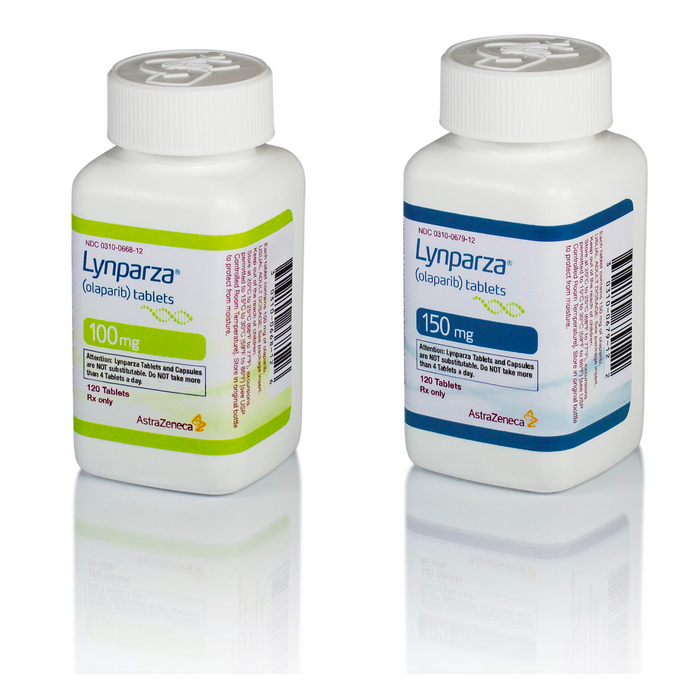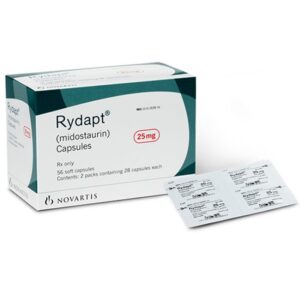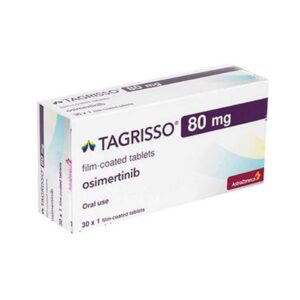Lynparza (olaparib) for sale – Buy Lynparza (olaparib) Online
What is Lynparza (olaparib) for?
Lynparza (olaparib) is indicated a poly (ADP-ribose) polymerase (PARP) inhibitor for the treatment of people with:
- Advanced ovarian cancer, fallopian tube cancer, or primary peritoneal cancer:
- With an abnormal BRCA gene. It is used alone as maintenance treatment after the cancer has responded to your first treatment with platinum-based chemotherapy.
- With an abnormal BRCA gene or a positive laboratory tumor test for genomic instability called HRD. It is used in combination with another anti-cancer medicine, bevacizumab, as maintenance treatment after the cancer has responded to your first treatment with platinum-based chemotherapy.
- As maintenance treatment, when the cancer has come back. It is used after the cancer has responded to treatment with platinum-based chemotherapy.
- With an abnormal inherited BRCA gene, and have received treatment with 3 or more prior types of chemotherapy medicines.
- Human epidermal growth factor receptor 2 (HER2)-negative breast cancer with an abnormal inherited BRCA gene, that has spread to other parts of the body (metastatic). You should have received chemotherapy medicines, either before or after your cancer has spread. If you have HR-positive disease, you should have been treated with hormonal therapy.
- Metastatic pancreatic cancer with an abnormal inherited BRCA gene. It is used as a maintenance treatment after your cancer has not progressed on at least 16 weeks of treatment with platinum-based chemotherapy.
- Prostate cancer with abnormal genes called homologous recombination repair (HRR genes). It is used when the cancer is metastatic, and no longer responds to a medical or surgical treatment that lowers testosterone, and has progressed after treatment with enzalutamide or abiraterone.
It is available in tablet form, containing either 100 mg or 150 mg of olaparib.[1]
How does Lynparza (olaparib) work?
PARP enzymes take part in normal cellular functions, including the transcription and repair of DNA.
In healthy cells, the reparation of DNA can happen via alternative mechanisms which do not involve the PAPR enzymes. These mechanisms require BRCA1 and BRCA2 proteins. Cancer cells with a mutation in BRCA1 or BRCA2 genes are not able to use these alternative mechanisms to repair their DNA, thus, when the remaining mechanism available (PARP enzymes mediated repair) is blocked by a PARP inhibitor such as olaparib, the damaged DNA in cancer cells cannot be repaired, and as a result, the cancer cells die[6,1]. In this way, Lynparza (olaparib) helps in the elimination of cancer cells.
BRCA gene mutations occur in approximately 15 to 20% of patients with ovarian cancer[4], approximately 20 to 25% of patients with hereditary breast cancers and 5 to 10% of patients with any type of breast cancer[8]. Although normally BRCA genes are involved in the reparation of damaged DNA and thus work to prevent tumour development when mutations in these genes can lead to the formation of tumours.
Where has Lynparza (olaparib) been approved?
Lynparza (olaparib) was approved by:
- Food and Drug Administration (FDA), USA:
- December 19, 2014[4], with an accelerated approval for the treatment of adult patients with deleterious or suspected deleterious germline BRCA-mutated (gBRCAm) advanced ovarian cancer who have been treated with three or more prior lines of chemotherapy
- August 17, 2017, for the maintenance treatment of adult patients with recurrent epithelial ovarian, fallopian tube or primary peritoneal cancer, who are in a complete or partial response to platinum-based chemotherapy[9]
- January 12, 2018, in patients with deleterious or suspected deleterious gBRCAm, human epidermal growth factor receptor 2 (HER2)-negative metastatic breast cancer who have previously been treated with chemotherapy in the neoadjuvant, adjuvant or metastatic setting[8].
- European Medical Agency (EMA), European Union (January 9, 2015[6]), Therapeutic Goods Administration (TGA), Australia (January 7, 2016[7]), and Medsafe (November 10, 2016[12]):
- monotherapy for the maintenance treatment of adult patients with platinum-sensitive relapsed BRCA-mutated high grade serous epithelial ovarian, fallopian tube, or primary peritoneal cancer who are in response (complete response or partial response) to platinum-based chemotherapy[2,3].
- Health Canada (May 3, 2019[11])
- Maintenance treatment of adult patients with advanced BRCA-mutated high-grade epithelial ovarian, fallopian tube or primary peritoneal cancer who are in response (complete response or partial response) to first-line platinum-based chemotherapy. Patients must have confirmation of BRCA mutation (identified by either germline or tumour testing) before LYNPARZA treatment is initiated
- Maintenance treatment of adult patients with platinum-sensitive relapsed (PSR) BRCAmutated high-grade epithelial ovarian, fallopian tube or primary peritoneal cancer who are in response (complete response or partial response) to platinum-based chemotherapy
- Treatment of adult patients with deleterious or suspected deleterious germline BRCAmutated (gBRCAm), human epidermal growth factor receptor 2 (HER2)-negative metastatic breast cancer who have previously been treated with chemotherapy in the neoadjuvant, adjuvant or metastatic setting. Patients with hormone receptor (HR)- positive breast cancer should have progressed on or be considered inappropriate for endocrine therapy. Germline BRCA mutation must be confirmed before LYNPARZA treatment is initiated[11].
This medicine has also been approved in Japan for certain indications. Please note that this medicine may have also been approved in other regions than the ones we’ve listed. If you have a question about its approval in a specific country feel free to contact our support team.
Maintenance therapy is the treatment of cancer typically following an initial round of treatment. It is usually given to patients whose cancer is undetectable after previous treatment, and it thus aims at either slowing the cancer’s return or lengthening the life of patients with advanced cancer[10].
How is Lynparza (olaparib) taken?
The standard dosage of Lynparza (olaparib) capsules is:
- 400 mg (8 capsules of 50 mg) taken twice daily[2,3]
- Continue treatment until disease progression.
The standard dosage of Lynparza (olaparib) tablets is:
- 300 mg taken twice daily[1]
- Continue treatment until disease progression or unacceptable toxicity.
Complete information about Lynparza (olaparib) dosage and administration can be found in the official prescribing information listed in our resources section[1,2,3].
Note: Please consult with your treating doctor for personalised dosing.
Are there any known adverse reactions or side effects of Lynparza (olaparib)?
Common adverse reactions
The most common adverse reactions listed in the prescribing information include[1,2,3]:
- nausea
- vomiting
- diarrhoea
- fatigue
- headache
- dysgeusia (distortion of the sense of taste)
- abnormalities in blood counts.
Serious adverse reactions
The serious adverse reactions listed in the prescribing information include[1,2,3]:
- Myelodysplastic syndrome/acute myeloid leukemia (MDS/AML) occurred in less than 1.5% of patients and the majority of events had a fatal outcome. All patients had potential contributing factors (previous chemotherapy with platinum agents and/or other DNA damaging agents including radiotherapy)
- Pneumonitis occurred in less than 1% of patients exposed to Lynparza, and were in some cases fatal.
Use in specific populations
Lynparza (olaparib) could cause fetal harm when administered to a pregnant woman. Lynparza should not be used during pregnancy and reliable contraception should be used during therapy and for 1 month after receiving the last dose of Lynparza. Breastfeeding whilst taking Lynparza is not advised[1,2,3].
For a comprehensive list of side effects and adverse reactions please refer to the official prescribing information[1,2,3].
References
- Summary of Product Characteristics [FDA]: Lynparza (olaparib) – tablets[PDF]
AstraZeneca, Jan 2018 - Summary of Product Characteristics [EMA]: Lynparza (olaparib) – capsules[PDF]
AstraZeneca, Jun. 2017 - Summary of Product Characteristics [TGA]: Lynparza (olaparib) – capsules[PDF]
AstraZeneca, Oct. 2016 - FDA News Release: FDA approves Lynparza to treat advanced ovarian cancer
Dec 2014 - Drugs.com. Lynparza
cited June 2017 - EMA. Human Medicines: Lynparza (olaparib),
cited June 2017 - TGA Public Summary
cited June 2017 - FDA News Release: FDA approves first treatment for breast cancer with a certain inherited genetic mutation Jan 2018
- FDA approved drugs: FDA approves olaparib tablets for maintenance treatment in ovarian cancer
Aug 2017 - Cancer.net: Understanding maintenance treatment
cited Feb 2018 - Summary of Product Characteristics [Health Canada]: Lynparza (olaparib) – tablets[PDF]
AstraZeneca, May 2019 - Product Detail [Medsafe]: Lynparza (olaparib) – tablets[PDF]
AstraZeneca, Oct 2019 - Metastatic breast cancer
AstraZeneca, cited on Dec 2020
This content has been reviewed by a Medical Doctor.







Reviews
There are no reviews yet.